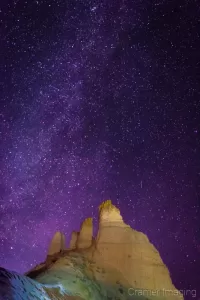
Have you ever seen something and just known that it would be important to you? I sure have. It’s happened more than once to me. Here’s the story of one such instance happening fairly recently for me and what I did with that feeling. It’s even a story of stars falling.
About a year or so ago, I had business take me along a stretch of local highway where I discovered this particularly interesting and unique looking rock formation. It seemed like a ruined castle to me. I haven’t seen anything else locally like it. So, I wanted to get a proper landscape photograph of it.
The difficulty for me was choosing the right kind of landscape photograph to take. I finally elected upon trying for an astrophotography shot with the Milky Way in the frame if possible. This meant that I had to time things with the galactic arms rising or setting. They also had to be visible in the correct direction. Thanks to tracking apps, I found the right time to attempt the shot. Wintertime skies are well known to be some of the clearest skies to shoot the stars from. I felt that I had the perfect window of time.
 My first several attempts didn’t turn out as planned. This sometimes happens so I become frustrated but I keep trying. Here recently, I decided to try again and got out to the site in time. It was bitterly cold and I had some trouble getting my hands to cooperate with the fine motor function required to change camera settings. That was immensely frustrating and could have been the end of the shoot that night.
My first several attempts didn’t turn out as planned. This sometimes happens so I become frustrated but I keep trying. Here recently, I decided to try again and got out to the site in time. It was bitterly cold and I had some trouble getting my hands to cooperate with the fine motor function required to change camera settings. That was immensely frustrating and could have been the end of the shoot that night.
My initial angle on the formation didn’t work out as planned so I ended up moving to a better vantage point which displayed much more of the deteriorating hoodoos. I was later to be grateful for this shift in position as this ended up being the angle I wanted. However, I still had another problem to contend with: getting a proper lighting balance between the dark skies while lighting up the formation in the foreground. To solve this particular problem, I tried a few different tricks but ended up settling on the technique of light painting to complete the job.
Light painting worked far better for this shot than I had imagined it would. I did several takes in order to make sure that I properly lit up the rock in front of me.
One surprise which showed up in several takes, including this one, was the presence of shooting stars. There’s one just above the central peak at about 2 o’clock. It’s not as prevalent as some other examples of the sky that night, however, this shot best featured both the landscape and sky properly exposed. So, I went with this shot including falling stars.
I know that this isn’t the best and brightest part of the Milky Way. That portion of the galactic arm has long set by the time it gets dark enough to see it. Perhaps, if things line up properly, I’ll try this shot again with a much brighter and more contrasty part of the galaxy in the future. Now that I know light painting is key, perhaps the shot will be stellar, pardon the pun. However, I’m not so sure I’ll be lucky enough to capture stars falling again.
Join our email-only photo of the week club to get the full stories behind how we captured our favorite fine art landscape photos.
We respect your privacy.


Receive monthly updates in your inbox from us.

Join our email-only photo of the week club to get the full stories behind how we captured our favorite fine art landscape photos.
We respect your privacy
No More Results